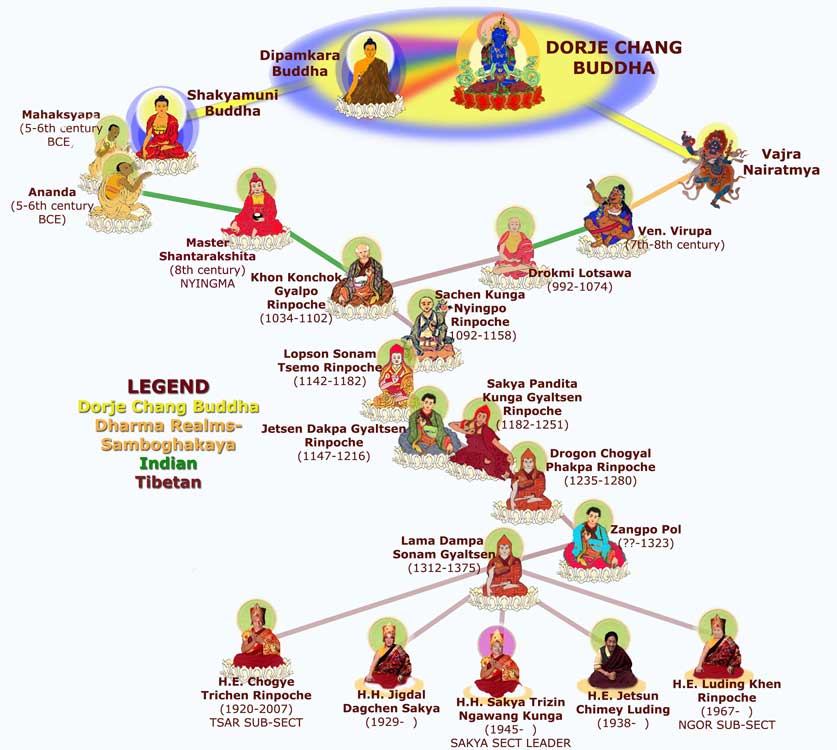 This Tibetan school, founded in 1073, has a hereditary leadership within the Khon family with married lamas and leaders, but it traces its Buddhists roots back to the eighth century to one of the seven original monks ordained by Master Shantarakshita. Its highest teachings include the “Hevajra Dharma” which was transmitted to the Indian Mahasiddha Virupa by Nairatmya, the consort of Hevajra Buddha who is the wrathful form of Akshobhya Buddha. In the eleventh century Drokkmi (992-1074) went to India from Tibet to receive these teachings which he transmitted to the first Khon patriarch, Konchok Gyalpo (1034-1102). Its most famous leader was Dharma King Sakya Pandita (1182-1251) who along with his nephew, Drogon Chogyal Phakpa or Choegyal Phagpa (1235-1280), were instrumental in converting the Mongolians to Buddhism. The Sakya School was politically influential in Tibet during the 13th and 14th centuries. Although it was the smallest of the four major Tibetan schools, it also has many groups established in the West with its main temple located in Walden, New York. H. H. Sakya Trizin Ngawang Kunga (1945-) is the current supreme head of the school. The leadership of the school has alternated between two branches of the Sakya clan with the head of the other branch, H. H. Dharma King Jigdal Dagchen Sakya (1929-) living in the USA. There are two main sub-sects, the Tsar, that was headed by the late H. E. Chogye Trichen Rinpoche, and the Ngor, headed by H. E. Luding Khen Rinpoche. H. H. Sakya Trizin’s sister, H. E. Jetsun Chimey Luding, and H. H. Jigdal Dagchen Sakya’s wife, H. E. Dagmo Kusho Sakya, both have centers and disciples in North America as well.
This Tibetan school, founded in 1073, has a hereditary leadership within the Khon family with married lamas and leaders, but it traces its Buddhists roots back to the eighth century to one of the seven original monks ordained by Master Shantarakshita. Its highest teachings include the “Hevajra Dharma” which was transmitted to the Indian Mahasiddha Virupa by Nairatmya, the consort of Hevajra Buddha who is the wrathful form of Akshobhya Buddha. In the eleventh century Drokkmi (992-1074) went to India from Tibet to receive these teachings which he transmitted to the first Khon patriarch, Konchok Gyalpo (1034-1102). Its most famous leader was Dharma King Sakya Pandita (1182-1251) who along with his nephew, Drogon Chogyal Phakpa or Choegyal Phagpa (1235-1280), were instrumental in converting the Mongolians to Buddhism. The Sakya School was politically influential in Tibet during the 13th and 14th centuries. Although it was the smallest of the four major Tibetan schools, it also has many groups established in the West with its main temple located in Walden, New York. H. H. Sakya Trizin Ngawang Kunga (1945-) is the current supreme head of the school. The leadership of the school has alternated between two branches of the Sakya clan with the head of the other branch, H. H. Dharma King Jigdal Dagchen Sakya (1929-) living in the USA. There are two main sub-sects, the Tsar, that was headed by the late H. E. Chogye Trichen Rinpoche, and the Ngor, headed by H. E. Luding Khen Rinpoche. H. H. Sakya Trizin’s sister, H. E. Jetsun Chimey Luding, and H. H. Jigdal Dagchen Sakya’s wife, H. E. Dagmo Kusho Sakya, both have centers and disciples in North America as well.
Iconic One Theme | Powered by Wordpress
